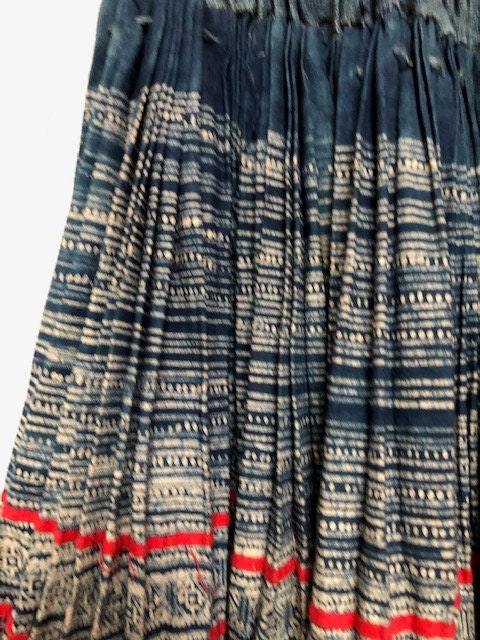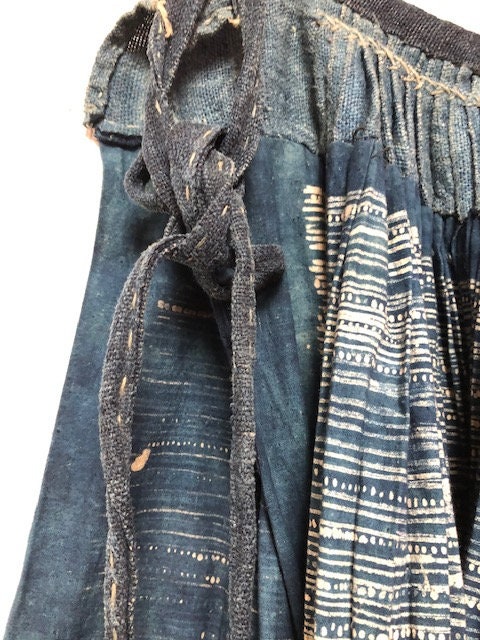1
/
of
10
Hunter Gatherer
Vintage Vietnamese Hmong Embroidered Tribal Skirt
Vintage Vietnamese Hmong Embroidered Tribal Skirt
An exquisite, authentic, tribal Hmong skirt from the Northern Vietnamese hill tribes. Made of dyed, indigo hemp with ribbon like embroidered pieces in repeated patterns and colors, hand stitched applique with cotton and silk threads.
The Hmong claim to originate from the Yellow River region of China, in around 3000 BC; though some experts state it was later than this. It wasn’t until the 1800s that they began to migrate; first spreading to Indochina, then to Northern Laos, Burma, Thailand and Vietnam, to avoid oppression.
The Hmong have a rich, fascinating culture that is apparent in their beautiful, tribal costumes. Rich in embroidery, festooned with layers of colorful embroidery it becomes apparent that textiles play an integral role in Hmong culture. Girls as young as five are taught to embroider, to prepare them for the tasks of creating marriage and funerary fabrics in later life. Later the girls are taught the more complex processes of indigo dying, garment construction and applique.
Hmong fabrics are renowned across the world; thanks to their rich colors and intricate designs. Their story cloths are particularly celebrated. Prior to the 20th century, the Hmong had no form of written language, and instead, communicated ideas and narratives onto beautifully intricate pieces of cloth. This practice wasn’t limited to females – even the male members of the village would create story cloths, to convey the story of their people to the outside world, and in some cases, to reveal the extent of their persecution.
I think the Hmong textiles are extraordinary and stand out rich in history, color and design. A simple skirt becomes a piece of art when hanging on the wall.
Measurements are 27 3/4” wide at the top. This does not include the indigo ribbon belt. 25 1/2” top to bottom. The bottom of the accordion like skirt measures a total of 156”.
The Hmong claim to originate from the Yellow River region of China, in around 3000 BC; though some experts state it was later than this. It wasn’t until the 1800s that they began to migrate; first spreading to Indochina, then to Northern Laos, Burma, Thailand and Vietnam, to avoid oppression.
The Hmong have a rich, fascinating culture that is apparent in their beautiful, tribal costumes. Rich in embroidery, festooned with layers of colorful embroidery it becomes apparent that textiles play an integral role in Hmong culture. Girls as young as five are taught to embroider, to prepare them for the tasks of creating marriage and funerary fabrics in later life. Later the girls are taught the more complex processes of indigo dying, garment construction and applique.
Hmong fabrics are renowned across the world; thanks to their rich colors and intricate designs. Their story cloths are particularly celebrated. Prior to the 20th century, the Hmong had no form of written language, and instead, communicated ideas and narratives onto beautifully intricate pieces of cloth. This practice wasn’t limited to females – even the male members of the village would create story cloths, to convey the story of their people to the outside world, and in some cases, to reveal the extent of their persecution.
I think the Hmong textiles are extraordinary and stand out rich in history, color and design. A simple skirt becomes a piece of art when hanging on the wall.
Measurements are 27 3/4” wide at the top. This does not include the indigo ribbon belt. 25 1/2” top to bottom. The bottom of the accordion like skirt measures a total of 156”.
Regular price
$265.00
Regular price
Sale price
$265.00
Unit price
/
per
1 in stock
Couldn't load pickup availability
Share




















